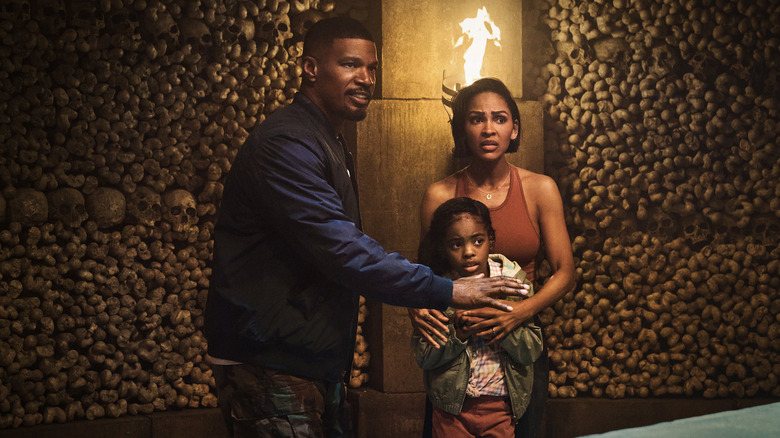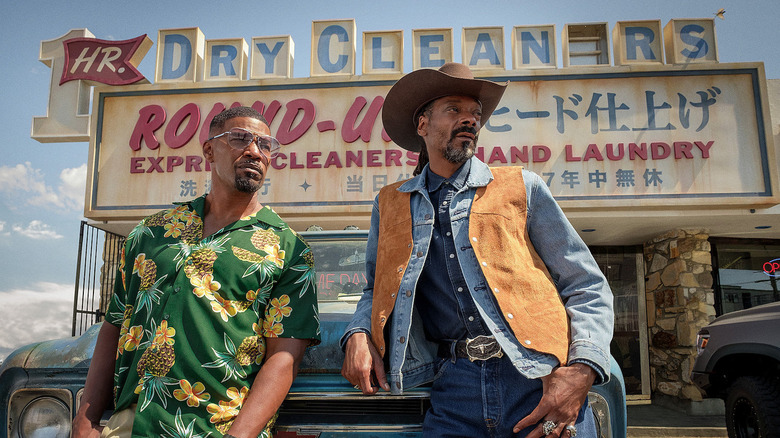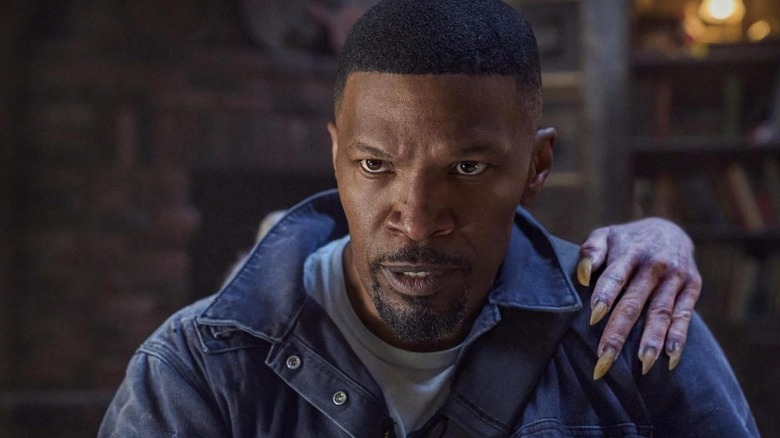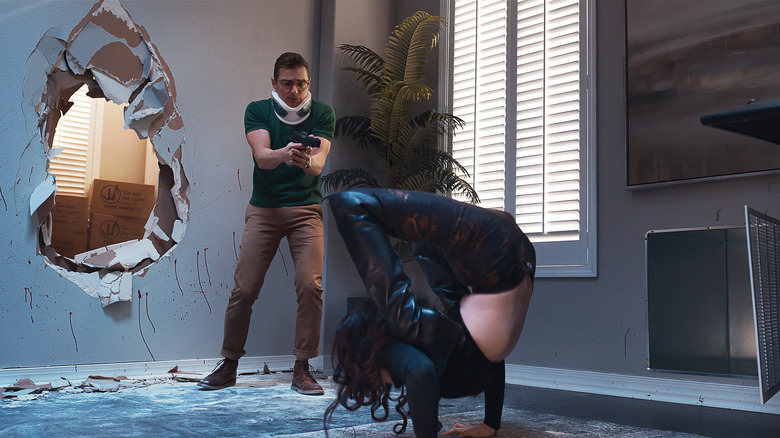Day Shift Director J.J. Perry Deserves A Doctorate In Crafting Action Scenes [Interview]
J.J. Perry knows what's doing in this business. Calling him a first-time filmmaker isn't exactly accurate. "Day Shift" is his first feature film, his first "directed by" credit, but Perry has been making movies for over 30 years. The stunt coordinator, stuntman, and second unit director's list of credits is seemingly never-ending, including "John Wick: Chapter 2," "The Rundown," and the "Mortal Kombat" movies.
All those years of experience shine bright in his vampire action-comedy, "Day Shift," which is modern in action and old-school in its references. When Perry started getting offers to direct a feature of his own, he knew what he didn't want to make as a filmmaker. "I definitely was not trying to make 'John Wick' with vampires," he told us. "Although John Wick has some comedy when he says, 'Oh, the blade is in your aorta, remove it and you will die. Professional courtesy.' I think that's funny." Recently, we talked to Perry about action and what he wanted to achieve with his feature directorial debut, and we gladly would've listened to him talk action all day.
'There's an added pressure there that directors, normal directors never feel'
When did you finally decide you wanted to direct a feature film?
So, I've been a second unit director for about 20 years. Do you know what second unit directing is?
You're mostly responsible for shooting the action.
It's pretty much directing all the action in the big action movies for them. Getting the opportunity to direct first-unit was huge. I was super stoked doing what I was doing at the time, like coordinating and second directing. I was making a ton of dough with all my friends, going all over the world. And after we did "John Wick 2," I started to get a lot of scripts.
There were dark scripts about soldiers with PTSD because I was a soldier. "Oh, this would be good for you." I was like, "No." "Oh, you can do another 'John Wick' kind of movie." And I was like, "No, I don't want to do that." As soon as I read "Day Shift," I knew I had to do this movie because I grew up in the '80s with "Big Trouble in Little China," "Lost Boys," "Evil Dead," "Fright Night," the action-comedy-horror genre in no particular order. As soon as I read "Day Shift," I knew I had to do it. I started working on it and just put all my chips on that one. And here we are.
How rare is it for the director, in your experience, to be shooting the action?
No, the second unit always does. There's guys out there that are crushing, like Darren Prescott, Garrett Warren. These are other masters of this craft. I hope soon that they will all get a shot at directing as well.
Another one, [stunt coordinator] Brett Chan, he's fantastic.
There's a brother. He's a good bro of mine. A good bro of mine. If you talk to him, tell him J.J. said what's up.
He's said when directors are wise enough, basically, they let him shoot the action in "Warrior."
So I worked in Hong Kong quite a bit in the early '90s and in the mid-'90s, when it was Hong Kong and then when it went back to China. What happens there, that's why their action movies are — well, action is a star of their movies. When the dialogue stops, the director gets up and leaves and the action director takes the chair. And that's how it goes. And that's kind of how it's gone for the last 10 or 12 years on big budget Hollywood movies with tons of action. They've got a whole separate unit somewhere else, shooting a sequence. And then they go back in the end of the movie and tie it together on a blue screen, whatever little elements on a motion capture stage or whatever.
I will tell you, my friend, that it's infinitely — now that I've done both, directing a big car chase through a city or a big scene, a big, big, huge fight scene where there are 30 people going at it in a room with fire and explosions, is a lot harder than directing a couple of guys talking in a room. Not just the technical part, but also you also are dealing with the risk of somebody getting killed or hurt, as a second unit director. There's an added pressure there that directors, normal directors never feel.
I'm not bagging on directors. Listen, respect, it's a blessing to be able to do this work. But yeah, I think it's much harder to [direct] the action than it is to [direct] the acting. I don't have any experience working with bad actors. So maybe when you have bad actors, it's very difficult, but I was very blessed to have amazing talent in "Day Shift."
When you were casting, was it important to cast actors you knew you wouldn't have to cut away from during action scenes?
I've worked with Jamie before. He's an amazing athlete. I've watched him do 42 pull-ups when he has a pull-up bar. He did 98%, the only thing he didn't do is, he didn't get wrecked. We didn't pull him into the floor, on a ratchet. But yeah, Dave Franco, too, Snoop, it was important to me we had willing accomplices.
I didn't need any stars or divas. I mean, they're all movie stars, but they were all super cool. They were all partners in crime. Everybody gave it all up. Carla, Megan, Natasha, also — everyone trained. We ran a little bootcamp. It was bada**. As soon as we saw how good they were, it influenced the way that I captured it.
Whenever you're doing an action scene, you look around a location and say, "All right, what would be the worst possible thing that could happen in this location?" In the house attack sequence with Scott Adkins, you get to go wild in that regard. How was it putting together that sequence?
So, I have this amazing stunt team that I work with. We go around the world, do these movies, stunt coordinating and second unit directing and these amazing — Justin Yu, Mike Lehr, Troy Robinson, Allegra, just this whole team of animals, all the way back to "John Wick 2." It's been seven years I've been on the road with them. I've had the same team, and we call it "the doomsday scenario." In other words, when we go in immediately, they start looking for rusty nails. In the chair that I'm sitting in, flip it upside down, you've got four legs standing up. You want to throw them on that. And then, it's always the worst case scenario. And then I had Greg Barry, my production designer, who's a dear friend of mine, I've worked with him for years. That's the benefit of being in this business so long: You learn and you work with all these amazing people.
When it was time for me to pull my team together, I just pulled some of the coolest people and some of the best people I knew. A lot of times when you're making a movie, there's 20 departments and they kind of interface. But in my movie, I made sure we were all were moving as one cohesive unit. Because at the end of the day, I knew which direction we were going to look. If I'm not going to turn around, we don't have to light over there, you know what I mean? We're going to look this way. Also, in the house that we built, one of the walls [was moveable] — you don't see in one of the fights, in the middle of a fight, we pull a wall and we put it back, because the camera wraps around. There was a lot of intricacies in there that we did, that were built into the preparation of the movie. There was a great collaboration between all of my departments to make all of these action scenes work.
'The action is the star'
In your experience, how many cameras do you use and what choices with them result in the best action?
Typically, I have three cameras on set when I'm doing hand fighting. I shoot, I'm cutting in A camera, but I'm protecting with B camera and C camera, searching for something. I use top shots a lot for a lot of fight choreography. What makes choreography interesting to me is creating a problem and then showing how it's solved. So, for me, the way that you capture choreography is dictated by the choreography itself and the venue you're doing it in. So we have an idea, when we're doing it, when we're pre-vizing, we're doing it in a room with boxes. We put the camera where the action is the star. There's no movie star there or no character star — the action is the star. We get a good look at the action: What are the groovy parts of the action? Then we put it into the build. Once it's built, we go in and redo and shoot. It really dictates the way it's filmed. Car chases are much more difficult, because you have a lot of more things going and it's a lot more coverage and you have to use a lot more cameras.
The drone photography in that car chase is very good.
Listen, since "Day Shift," we've been R&D'ing a bunch of stuff. I will reinvent car chases with that drone, just because of the being in the car, behind the driver and the passenger, then throwing the drone out of the sunroof and going to the next car and doing that all over again, is a perspective that the audiences haven't seen before. Do you remember when the Russian Arm came in the late '70s or early '80s? The Russian Arm, it's a high performance car with a crane arm. It has a remote head on the front of it. It changed the perspective of driving, of car action that hasn't been seen, and no one's done anything to change that since then. Now, this drone photography gives you a new perspective the audience hasn't seen. I think on our sophomore effort, or my sophomore directing effort, if I get a chance to do big car chase, I think we will knock that out of the park.
When you get to the editing room, how do you know you've hit the right speed and cutting rhythm for the action scenes?
You want to run the take as long as it'll go. The whole idea of oners is cool, but if you're doing a oner just to do a oner as a gimmick, people already been doing that. You're not going to beat "Oldboy," the original, no matter how good you are. I mean, it's a dolly with a slow push and 30 guys beating each other up. I think it's cool to [have] oners, but I just think that if you want to make an impression, if you want the action to be bada**, you have to do what's best for the action in the movie. The action has to service the story.
Editing, for me, when we're shooting our action sequences, is literally going to the DIT [Digital Imaging Technician], dumping it and cutting it right there so we have real time intel on how we're doing. So that's part of the team that I have with me. That's part of the things that we've been doing on the road. In the last seven years, it's been a constant and it's helped make the action in the movies better because it informs what we do, if we need something else or is this perfect? I think that editing the action, we create the action together. We already are speaking the same language. My team and I are in lockstep on what it should look like.
As a stunt coordinator, second unit director, I pre-viz. Then as a second unit director, I shoot and cut. I shoot the action and then I edit it and I deliver it to the director as proof of concept and then proof of execution. It's up to them at that point how they want to cut it. It's not my movie. As a second unit director, my job is to help the director with his or her vision of what the action is. So when I'm second unit director, I give, "This is the cut that I promised you. Hope you love it. And when you give it to your editor, you guys can do whatever you want with it. But this is proof of execution. This is what we talked about doing, here it is."
Then it's just a matter of taste, right?
Listen, it's all opinions. When we look at something, if we look at the same picture, you are going to see something different than me. You're not going to make everyone happy. As an action director, one of my jobs is to have my finger on the pulse of what I think the target market that I'm doing the action for, what they like. That's one of the things that's in the skill set that I'm required to do. I can't just do what I think is cool, because it'll be a big kickboxing tournament with guns. I have to do what services the story and what I think our target market is going to like. You have to be able to make the salad from all different ingredients all the time.
I do think you maybe just struck gold with the kickboxing idea.
I love it, brother. Come on, let's do it together.
'When I got out of the army, I never thought I'd be doing any of this'
For Jamie Foxx, how'd you want his character to fight and move?
I made Jamie as much like me as I could, because we're the same age. We're both from Texas. I was in the army. You saw when he's in the shower, he has the 82nd airborne tattoo, and he's working as a loan operator. When you're in the army, you're working on the squad level, platoon level and squad levels. You're working, you've got six or seven men or women in a stack with you. As a loan operator, when you come in, you can't watch your own six. That's why he puts the wire, so he's protecting himself. He's put an ambush in the back.
I wanted to make him smart. I didn't want to give him a style of fighting, like, "Oh, he's a judo guy." I wanted to be ambiguous. He's a scrapper. He'd been in the army. He'd been to combat. There's a couple of karate trophies in his apartment that the camera pans off of, whether you see it or not; there's a boxing trophy, a karate trophy. You just have to hint that he's got a background in maybe some martial arts or whatever, and that's the way I played it with Jamie.
With all the contortionists, I mixed contortion work with lucha libre and MMA, within the movement. So you saw when the old lady gets him, she puts him in the crucifix. You saw the lucha libre entries there. The character Heather (Natasha Liu Bordizzo) as well, she did some lucha libre to get off of Jamie in the apartment. I think lucha libre, Mexican wrestling, is super fun and interesting and super dynamic. You don't need wires to do it. You just need game-bred performers to do it.
Snoop, of course, was interesting because — I'm going to call him Calvin Broadus, because that's who I hired. I didn't actually hire Snoop. I hired Calvin to play Big John in my movie, because I think everybody hires Snoop to be Snoop in their movie. He reminds me of my old platoon sergeant, and I'm a big fan of his. When I hired him, no one had seen him kick a**, and he's actually quite handy. He's really handy as a martial arts guy. He's a very avid martial artist, boxing, all that stuff.
I want to go back in time a bit to your Hong Kong days. What did you shoot there?
The first one that I did was a movie called "Enter the Eagles," and it starred Bruce Lee's daughter, Shannon Lee, and Benny Urquidez, Benny the Jet, who's one of my idols at kickboxing. I played his little brother. Corey Yuen was directing and we shot two months in Prague and then three months in Hong. It was the first time I went. This is probably '95 or '96 and right before I did the "Mortal Kombat" movies.
You get there and you have to really pay attention, especially back then because they're speaking Cantonese and they're choreographing stuff very fast and they expect you to learn it immediately. So you have to watch everything, because I don't speak Cantonese. But they were super cool, super efficient because they're shooting with one camera and super wild.
I remember Corey came to me and he says, "So J.J., after this, you're going to do one big weebo stunt." And I was like, "Weebo stunt?" And he was like, "After stunt, weebo, weebo, weebo." So that meant he was going to 86 me. I got knocked out and it was beautiful. It was odd, but the shot looked great. I got ratcheted across a room into an electric box and they didn't have ratchets. It was six of the Chinese stuntmen on a ladder with a bunch of sandbags. They jumped off the ladder and pulled me across the room and smacked me into this thing. So that's what we call a weebo stunt in Hong Kong: You know you're going to get 86'd, brother.
[Laughs] So it was a great experience getting knocked out.
It was awesome. Listen, every experience in this business — when I got out of the army, I never thought I'd be doing any of this. I'm just super grateful for all the experiences I've had. All over, 36 countries. I didn't go to college. I didn't really have any film school, none of that. I got out of the army and I became a stuntman and I just never said no to anything. I said, "I'm going to embrace this and I'm going to go on the ride." I got to work with some of the greats and it's been a real hoot and I never expected any of it. I'm grateful for every minute of it. So, for me, all of it has been amazing. All my experiences in Hong Kong, Thailand, I mean 36 countries, brother. It's been amazing.
What have been some of the best countries you've worked in?
I got to tell you, I love Hong Kong. I love Thailand. England is sick. Hungary is ridiculously cool. Australia, New Zealand, any cities that are on the water, like Sydney or Vancouver. Those cities on the water where you're taking water taxis and you know you're going to get thrown in the drink, probably, as a stunt man. So if the water's cold, it sucks. But if the water's warm, it's bada**. Hawaii's bada**. "The Rundown" we did in Hawaii. Listen, I haven't really had a bad experience anywhere. It's like I said, it's been a blessing to get to do this work. It's really been a blessing. Every movie I've been on, I cherish it.
Do crews tend to work differently wherever you go? Like, in Hong Kong, they were notorious for moving fast and everyone helping to do everyone's job on set.
Absolutely. We have unions here and that changes things a bit, but I'll give you an example with "Undisputed II." That was a good movie. It's a movie with Scott Adkins and Michael Jai White, a million dollar budget movie that we did back in Bulgaria in 2003. I got to operate the camera, and we did a little bit of everything. It was like one of my first big second unit directing jobs. It was a great experience for me. And that's part of it, too. When we're shooting, pre-viz, we're operating cameras, we're editing, we're building little makeshift props. Doing pre-viz is actually filmmaking, strangely. All the guys that do pre-viz will inform you on how to be a great director. So yeah, the different countries have different methods. I still think Hollywood now, we were behind [Hong Kong] a little bit in the fighting in the '90s. But once Hong Kong came here and left, I think we've surpassed them. I think we've totally surpassed them. If you look at what's coming out of Hong Kong now, it's not great.
Why do you think that is?
I think that China and Hong Kong now, it's just a different climate there, maybe, politically or whatever. But look at South Korea making great films. Thailand had "Ong-Bak" come out 20 years ago. It was refreshing to see "Ong-Bak." Japan makes great action films. France, England, I mean, all the world now, because right now there's more content being made than any time in the history of TV, cinema, film. More content being made means more experience. People are getting way more experience. More people are getting in the business. And now that technology grows exponentially. When I started in stunts, you couldn't say, 'Let's just fix it in post." You had to figure out how to do it. Now, well, there's a zillion ways to make it better.
"Day Shift" will be available to stream on Netflix on August 12, 2022.



